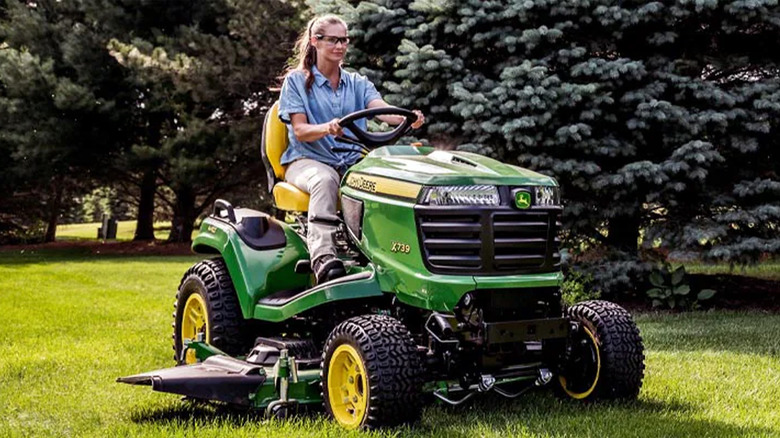
When I purchased my house in 2019, the owners didn't leave a lot behind, including taking most of the kitchen appliances with them
. One of the things they did part with, however, was a Craftsman DYS 4500 riding lawnmower, which was my introduction to riding mowers. In the six years since then, I have used my mower primarily for cutting grass, as that is its primary function. I have also used it to mulch leaves and perform other tasks.But, if you've ever wondered what else this little tractor could
do, you're not alone. It turns out, you can do quite a lot. It's not necessarily that there are a billion attachments available, but the attachments that are available allow you to do a number of things besides mow. For the most part, as long as your being safe and not over-stressing your mower's engine too much, you can do basically anything you can think of from hauling items to cleaning up leaves. We'll get more into that later.
If you're looking to use your mower for more than just tackle the lawn, we do recommend keeping an eye on your engine's power. If you try to do too much with too small of an engine, it'll cause failure, and that can be a hefty price for repairs.
Read more: 6 Useful Third-Party Accessories For Your DeWalt Tools
Leaf Pickup (And Grass Clipping Cleanup)
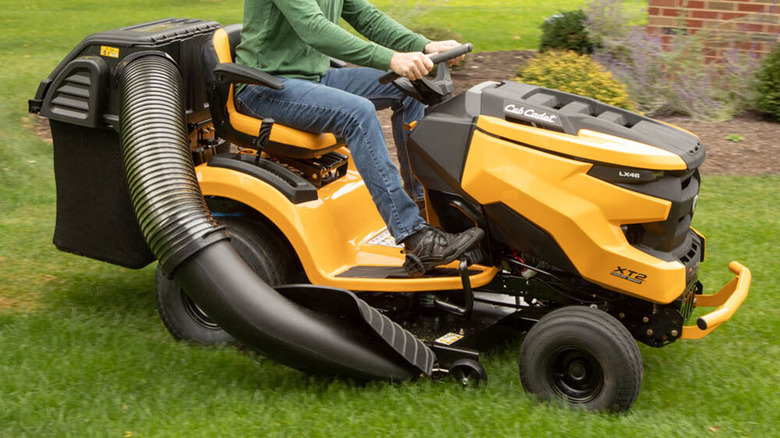
Let's start with the most obvious extension of your mower's capabilities and that's leaf cleanup. My neighbors and I do this every year. Simply attach a bagger to your mower and then you vacuum up the leaves. The blades chop them up, allowing you to fit a surprising amount in your bagger. Once full, empty them out into a yard waste bin for local trash pickup or toss them into a yard bag. My neighbors and I dump ours into a pickup truck and take them to a local mulching business where they accept leaves for free.
This is a great place to start because baggers can be used for mowing the lawn as well, so it's a natural first step to adding attachments to your mower. For leaves, it's quicker than raking by a country mile, and I use mine to clean up grass clippings as well. That way my dogs don't track loose grass into the house when they feel like rolling around in the yard.
Plus, baggers are fairly easy to find from both first- and third-party sources. The only difficult part is making sure the bagger fits your particular riding mower, which can be a bit of a chore. Your best bet to doing that is contacting sellers, your mower's OEM, and places like Reddit. It can be a bit of a pain, especially if yours is an older mower like mine, but once you have one, you can clean up your yard very quickly.
You Can Plow Snow
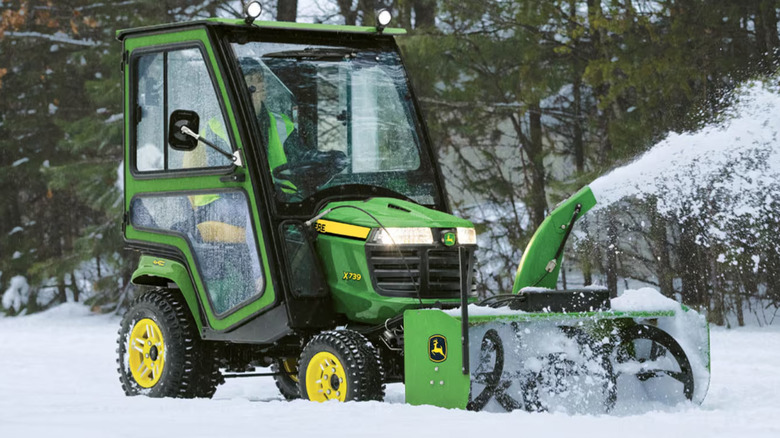
Another popular use for riding mowers outside of mowing is for snow removal. This one is a bit complicated because you really want to pay attention to your engine's horsepower here. After all, snow is heavy, so if you use a plow, you may strain the engine too much. In any case, there are three ways to clean up snow with an attachment. There are snowblowers that you can find from makers like John Deere, regular snow plows that just attach to the front, and rotary brooms that brush snow out of the way.
The choice is yours, but it's worth noting that the ones that require power, like the plow and the brush, will heavily depend on what kind of mower you have. For example, John Deere's snow blower attaches to the deck, so you'd attach it to your driveshaft, using the same power to run the blower as you would your mower blades. Not every lawnmower can handle that. So, for the most power, the unpowered plow is probably your best bet unless the blower or brush specifically say that they work with your particular mower.
The rotary brush is also a pretty cool option. In addition to snow, the rotary brush can also clean pathways without snow, removing things like dirt, other debris like sticks and rocks, and alike such things. Being able to clean up after just about anything is a nice addition to snow, making it the most versatile option.
A Mower Can Haul Stuff
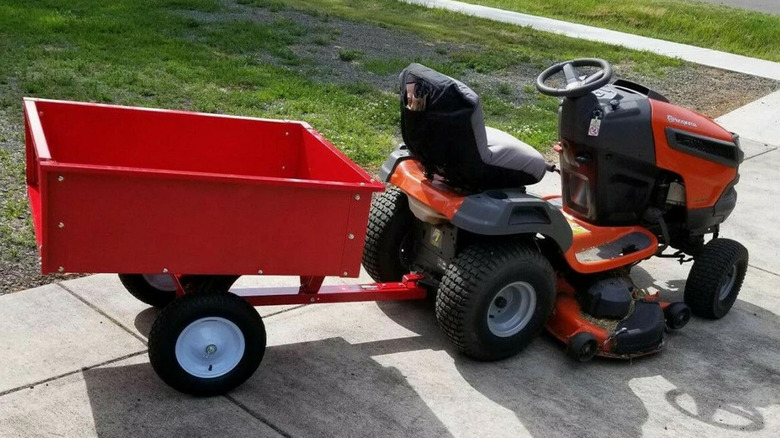
Nearly every riding mower can attach something like a trailer cart to the back. You can typically find them online at a variety of stores, including places like Harbor Freight, and you don't have to worry as much about compatibility as you do the snow blower or bagger attachments. As long as you can get a trailer hitch on your mower, you can use one of these. However, we will reiterate the warning about your mower's engine, as many weren't meant to tow heavy things like a pickup truck.
Once you get this thing attached, the only limitation is your imagination and your mower's engine horsepower. You can carry firewood, haul sticks and debris, move rocks, pick up bags of yard trimmings, move leaves, or even drag bags of sand, dirt, mulch, or gravel. You can even pull equipment if you have a higher end lawn tractor with a stronger engine, like the three-cylinder diesel on high-end John Deere mowers. It's not something we recommend doing every day since it can wear down the mower engine over time, but if you need to carry something, your mower can do it if it needs to, adding to its versatility.
Like most attachments, we recommend checking out your mower's manufacturer to see if any official attachments exist for this sort of stuff. For example, John Deere sells a cart specifically for its lawn tractors. If you can't find one, anything will do, just be careful.
Fertilizing And Aerating Are Other Options
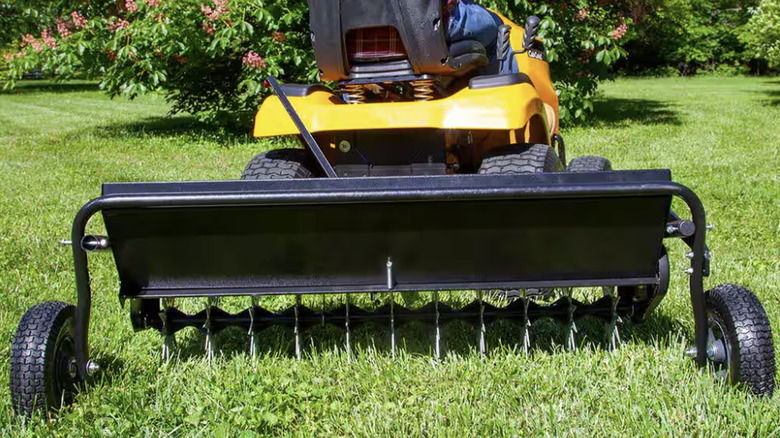
Fertilizing and aerating your lawn is where we start to get into niche territory, but it's still rather useful if you do this regularly. You can buy tow-behind spreaders and aerators for your riding mower, and often the two come as a two-in-one combo unit. Much like the trailers above, you don't necessarily need OEM-specific parts for this. If you can get a hitch onto your mower, you can pull one of these as most of the third-party options are universal. Some recommend that you ride at a "walking pace" when doing it so you don't stress the transmission too much.
The use cases here are fairly self-explanatory. You can use spreaders to lay down grass seed, fertilizer, or weed killer pellets. I've done this with my walking spreader almost every year. The aerator works much the same way. Pull it behind and it digs up little plugs in your yard, helping keep the soil healthy. It's generally recommended to fertilize, weed kill, and aerate once a year or so. If you have a big lawn, using your riding mower instead can save you a ton of time.
The only knock is the price. The aforementioned two-in-one aerator and spreader costs around $400. That's quite a lot for something you'll use once or twice a year. It's not something we'd recommend for a suburb-sized lawn; it's more for folks who live in the boonies and have much larger lawns to tend to.
Tilling And Cultivation
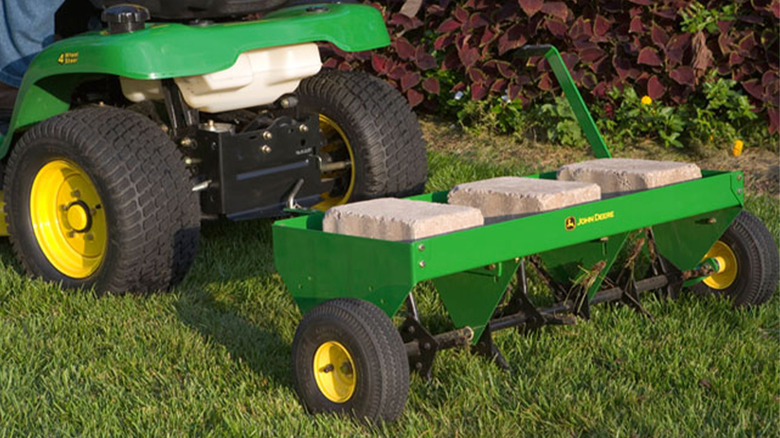
Those who want to go a step further can do some light farming with a riding mower as well. Okay, farming is probably too strong a word for the capabilities here. In any case, there are tillers and similar items on sale that you can attach to the back of your mower. Like snow blowers, these attach to your mower's driveshaft where the blades usually attach, so you're using the same power to spin those blades as well. Because of that, we only recommend this on higher-powered lawn tractors since this will almost certainly wear down weaker engines.
In any case, these things have their uses. You can use them to control weeks, clear out grass, and break up hard, compacted soil to get it prepared for planting. From there, you can use it to cultivate the soil, mixing it up and getting it ready to plant whatever you want from new grass to a garden. Since lawn mowers aren't designed for this kind of work, this sort of thing is incredibly niche, but if you do a lot of this type of work and your tractor is strong enough, then it's a viable alternative to doing it by hand or buying dedicated tools for it.
Some folks have done things like leveling their lawns with a tiller, although it requires quite a bit of cleanup after, so there are non-gardening and non-planting uses for it, but they are few and far between.
Want the latest in tech and auto trends? Subscribe to our free newsletter for the latest headlines, expert guides, and how-to tips, one email at a time.
Read the original article on SlashGear.










